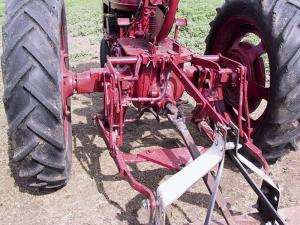2004 - Volume #28, Issue #5, Page #02
[ Sample Stories From This Issue | List of All Stories In This Issue | Print this story
| Read this issue]
He Added 3-Point Hitch To Farmall H
 |
"I built the whole thing with scrap I had laying around, except for some pins for the ball joints," says Francis.
He began by welding pins to the angle iron that connects the drawbar to the axle. The outer pins provide pivot points for the lower arms of the hitch. The inside pins provide a base for two hydraulic cylinders that lift the hitch.
Each arm was constructed from two 2 1/2 by 3/4-in. steel bars that were long enough to extend just past the drawbar. Balls welded to the end of the bars fit over the outside pins.
A second set of bars with balls were welded to one end to extend the arms' reach beyond the drawbar. The balls formed the implement receiving ends of the arms.
"The extensions had to be bent in about 4 1/4-in. on each side to fit around the drawbar and yet match implement hitch width," explains Francis.
For his third point, he bolted a steel plate to the tractor platform. He then welded a piece of 5 1/4 by 2-in. angle iron to the plate. It served double duty, holding pins for the ball joint for the third arm of the 3-pt. hitch. A second piece of angle iron welded to it forms a bracket to enclose the center section of a 31-in. long, 1 1/4-in. steel rod. This rod serves as the pivot point for the arm lift mechanism.
Francis then built a set of braces to pivot with the rod and serve as the lift mechanism for the hitch. Each brace is composed of one long outside steel strap and one shorter inside steel strap, both with holes drilled in one end, allowing them to slide over the rod. A third steel strap welded in place between them and at the end of the shorter strap completes the brace. A bracket made from a piece of angle iron is welded to the underside of the connecting strap. A pin welded to the angle iron accepts the shaft end of the hydraulic cylinder. The outside arm of each brace extends to a point directly above the midpoint of the lower arms. Adjustable brackets connect each brace to the lower arms and allow them to be leveled as needed.
When an implement is mounted on the hitch, Francis engages the hydraulic cylinders, pushing the braces upward and lifting the lower arms with them.
"My first cylinders were 2-in. rams, and they were too small. I replaced them with 4-in. rams and that helped a lot," says Francis. "I hooked up the hydraulics to left/right controls, so when I push the left one up, the rams push up. When I push the right one down, the rams pull down. It's nice to have the down pressure. It lets me dig postholes, even in hard ground."
Contact: FARM SHOW Followup, Larry Francis, 1065 N. 1750 W., Provo, Utah 84604 (ph 801 374-5956).

Click here to download page story appeared in.

Click here to read entire issue
To read the rest of this story, download this issue below or click here to register with your account number.




